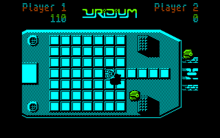Uridium
| Uridium | |
|---|---|
| Developer(s) | Andrew Braybrook (Commodore 64), Dominic Robinson (ZX Spectrum), Steve Turner (Music) |
| Publisher(s) | Hewson Consultants |
| Designer(s) | Andrew Braybrook |
| Platform(s) | Atari ST, Commodore 64, ZX Spectrum, Amstrad CPC, BBC Micro, Virtual Console, MS-DOS |
| Release date(s) | 1986 |
| Genre(s) | Shoot 'em up |
| Mode(s) | Single player |
| Distribution | Cassette tape or Download from the Wii Shop Channel |
Uridium is a science fiction side-scrolling shoot 'em up originally designed by Andrew Braybrook for the Commodore 64, and later ported to other 8-bit machines. It consists of fifteen levels, each named after a metal element, with the last level being called Uridium (a fictional metallic element, not to be confused with the real metallic element iridium). The manual quotes Robert Orchard, who invented the name as saying "I really thought it existed." [1]
Uridium was later released for the Nintendo Entertainment System in 1990. Mindscape purchased a license to release a game based on the film The Last Starfighter. Rather than program a new game, however, Mindscape decided to take an easier route by recycling an older, relatively obscure game. The title screen, sprites, and soundtrack were modified, but the levels and gameplay were identical. In 2003, it was re-released on the C64 Direct-to-TV.
In 2008, the C64 version was announced as a title on the Wii Virtual Console.[2] On 28 March 2008, Uridium was released for the Virtual Console in Europe, costing 500 Wii Points.
Plot
The plot of Uridium is described as follows:
The solar system is under attack! Enemy Super-Dreadnoughts have been placed in orbit around each of the fifteen planets in this galactic sector. They are draining mineral resources from the planetary cores for use in their interstellar power units. Each Super-Dreadnought seeks out a different metal for its metal converter.Your Manta class Space Fighter will be transported to each planet in turn and it is your task to destroy each Dreadnought. First you must attack the defensive screen of enemy fighters, then you must neutralise the majority of surface defences before you land on the Super-Dreadnought's master runway. Once on board you must pull as many fuel rods as possible from the metal converters before you take off for a final strafing run as the Dreadnought vaporises into the ether.
Gameplay

In practice, each level takes place at a fixed altitude just above the surface of the Dreadnoughts. The screen scrolls horizontally in both directions as the Manta flies over the Dreadnoughts. Each Dreadnought has a different configuration of walls and other structures which must be negotiated in order to reach the landing zone. This task is hampered by squadrons of enemy fighters that attack the Manta in waves. Lastly, flashing ports on the Dreadnought's surface release homing mines that cannot be destroyed. It takes a skillful Manta pilot to outfly the mines until they self-detonate.
Only when enough of the Dreadnought's defenses have been destroyed is the "Land Now!" signal activated, and the player allowed to slow its speed to a minimum land on the sternward landing zone. After this, the pilot presumably enters the interior of the mothership and sets its nuclear reactor to self-destruct. Finally, the Manta takes off again as the Dreadnought below it crumbles to atoms.
Later Dreadnoughts have tricky wall configurations where the gap between the walls is so narrow that the Manta must turn sideways in order to pass through it. This required skillful use of the joystick. More skill could be exhibited (and more points awarded) by ignoring the "Land Now!" signal and destroying the elite fighters that attacked in waves of one.
Technical details
When Uridium was originally released, reviewers were impressed by the way the Dreadnoughts were presented. In a simulation of parallax scrolling, the surface of the Dreadnoughts scrolls horizontally, whereas the stars in the background stay still.
Since the Commodore 64's graphics do not support parallax scrolling, particular trickery was required to achieve this. The way it was done is that the Dreadnoughts' surface is actually the background, and the black empty space and the stars are character glyphs on the foreground. As the Commodore 64's graphics chip scrolls the screen to the left or right, the character glyphs representing the stars change shape by shifting their single lit pixels to the right or left, countering the scroll of the screen and giving the impression they were stationary.[3]
Sequels
Uridium was followed by Uridium+, and Uridium 2 on the Amiga platform.
Reception and legacy
Computer Gaming World praised Uridium for its graphics' ability to display depth, as well as the game's robust controls.[4]
The game won the award for best shooting game of the year according to the readers of Crash magazine.[5] It was also voted Best Arcade-style Game of the Year at the Golden Joystick Awards.[6]
One of Andrew Braybrook's later releases, Morpheus, contained a homing mine enemy called an "Uridimine", named no doubt as a tribute to the homing mines of Uridium. Some afficiandos refer to the homing mines as "Uridimines" when talking about Uridium or Uridium 2, as well.
References
- ↑ "Uridium". TEMPE. Retrieved 2007-04-04.
- ↑ Commodore 64 coming to Virtual Console
- ↑ Hytönen, Pasi: Uridiumin ja Parallaxin grafiikka. C-lehti 1/1987, pp. 50-51. Available online at .
- ↑ Wilson, David (April 1988). "The Best Starfighter: A Comparison of Space Arcade Games". Computer Gaming World. pp. 24–25
- ↑ http://www.crashonline.org.uk/38/awards.htm
- ↑ http://www.worldofspectrum.org/showmag.cgi?mag=C+VG/Issue066/Pages/CVG06600101.jpg
External links
- Uridium at MobyGames
- Uridium at World of Spectrum
- Uridium at Lemon 64
- Uridium at CPC Zone
- Uridium Wii Virtual Console Review on VC-Reviews.com